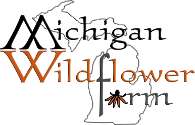The Michigan Native Plant Producers Association (MNPPA) is committed to purity in product of native seed and plant material as per our By-Laws, Article III, Section 2 (f) and Appendix 2 – Invasive Species. MNPPA members continue to be active in educating themselves, staff and customers on identifying and eradicating invasive species. MNPPA’s list of invasive species has been updated with the addition of Ameranth palmerii (Appendix 2).
Submitted by:
Esther Durnwald, Michigan Wildflower Farm
Jerry Stewart, Native Connections
Chad Hughson, Hidden Savanna Nursery
Bill Schneider, WildType Design, Native Plant & Seed, LTD
Grag Vaclavek, The Native Plant Nursery, LLC
MNPPA BYLAWS
Article III
Section 2. Membership Criteria
- Member businesses are to meet or exceed ethical and/or ecological criteria in the following areas:
- Wild collection and wild harvest (see Appendix 1 Wild Collection Guidelines)
- Accidental or purposeful production or distribution of exotic, invasive species (see Invasive Species Guidelines)
- Truthful advertising and labeling
- Abide by State and Federal Endangered Species Laws
APPENDIX 2
Invasive Species
The species listed below are non-native, invasive plants in Michigan. Once introduced, these plants can aggressively colonize natural areas, decreasing biodiversity and compromising the ecological integrity of an area. Member nurseries are expected to actively manage for the prevention of distribution of plants or seed of any of these invasive species.
This list was compiled by Greg Vaclavek for the Michigan Native Plant Producers Association.
References:
Natural Area Preservation, City of Ann Arbor Parks and Recreation Department, 1996,
Your Landscape and our Natural Areas brochure.
Schneider, William. 1992. Invasive Species Survey. University of Michigan.
The Nature Conservancy. Website, 1999. http://www.tnc.org
The Tallgrass Restoration Handbook; Packard and Mutel, 1997.
Latin Name, Common Name
Acer ginnala, Amur maple
Acer platanoides, Norway maple
Aegopodium podegraria, Goutweed
Ailanthus altissima, Tree of heaven
Alliaria petiolata, Garlic mustard
Amaranthus palmerii
Berberis sp. Barberry
Bromus inermis, Smooth brome grass
Cardamine impatiens, Bittercress
Celastrus orbiculata, Oriental bittersweet
Centauria maculosa, Spotted knapweed
Cirsium arvense, Canada thistle
Cirsium palustre, European marsh thistle
Convallaria majalis, Lily of the vally
Convolvulus arvensis, Field bindweed
Coronilla varia, Crown vetch
Daucus carota, Queen Anne’s Lace
Dipsacus laciniatus, Cut-leaved teasel
Dipsacus sylestris, Teasel
Elaeagnus umbellate, Autumn olive
Euphorbia esula, Leafy spurge
Festuca arundiacea, Tall fescue
Glechoma hederacea, Creeping Charlie
Gypsophila spp., Baby’s breath
Hesperis matronalis, Dame’s rocket
Hypericum perforatum, Common St. Johnswort
Ligustrum vulgare, Privet
Linaria vulgaris, Butter and eggs
Lonicera mackii, Amur honeysuckle
Lonicera tatarica, Tartarian honeysuckle
Lonicera morrowii, Morrow honeysuckle
Lonicera xbella, Asian honeysuckle
Lonicera xylosteum, European fly honeysuckle
Lonicera japonica, Japanese honeysuckle
Lotus corniculata, Birdsfoot trefoil
Lysimachia nummularia, Moneywort
Lythrum salicaria, Purple loosestrife
Melilotus alba, White sweet clover
Melilotus officinalis, Yellow sweet clover
Morus alba, White mulberry
Myriophyllum spicatum, Eurasian water milfoil
Pastinaca sativa, Wild parsnip
Phalaris arundinacea, Reed canary grass
Poa compressa, Canada bluegrass
Poa pratensis, Kentucky bluegrass
Polygonum cuspidatum, Japanese knotweed
Rhamnus cathartica, European buckthorn
Rhamnus frangula, Glossy buckthorn
Robinia pseudoacacia, Black locust
Rosa multiflora, Multiflora rose
Typha angustifolia, Narrow-leaved cattail
Ulmus pumila

